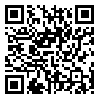BibTeX | RIS | EndNote | Medlars | ProCite | Reference Manager | RefWorks
Send citation to:
URL: http://ijrabms.umsu.ac.ir/article-1-38-en.html
Received 5 May 2015, accepted for publication 27 July 2015
Background & Aims: Nicotinic acetylcholine receptors (nAChRs) regulate epileptiform discharges generated by a number of different pharmacological manipulations, in the hippocampus. Functional nicotinic receptor-mediated responses are most prominently observed in hippocampal interneurons, however the pro-epileptogenic action of nAChRs appears to be independent of fast GABAergic transmission since it is resistant to the blockade of GABAA receptors. To identify possible contribution of the GABAB receptor in the nAChR-induced effect, a set of experiments was carried out in the presence of GABAB receptor antagonist CGP55845A.
Material and Methods: Hippocampal slices (400µm thick) were prepared from male Wistar rats (3-4 weeks). Following a 1hr equilibration in artificial cerebrospinal fluid, slices were transferred to a submerged-type recording chamber. Extracellular field recordings were made in the Stratum pyramidale of the CA3 regions. Bath application of the convulsant compounds 4-aminopyridine (4AP) or bicuculline resulted in the development of spontaneous epileptiform bursting.
Results: Slices pre-incubated with CGP55845A (GABAB receptor antagonist) were not able to exhibit burst frequency potentiation of 4AP-induced epileptiform activity upon application of the selective nAChR agonist dimethylphenylpiperazinium iodide (DMPP -8.3 ± 7%, n=11). Similarly, in the presence of CGP55845A, slices exhibited negligible burst frequency potentiation of bicuculline-induced epileptiform activity upon DMPP application (27.6 ± 18%, n=9), in comparison to those observed in the absence of CGP55845A (248 ± 76 %, n=14). The suppression of epileptiform activity by the GABAB receptor agonist baclofen, was partially recovered by subsequent co-application of DMPP (n=10).
Conclusion: These data suggests that nAChRs may regulate the excitability of hippocampal networks at least in part through GABAB receptor-mediated mechanisms.
| Rights and permissions | |
 |
This work is licensed under a Creative Commons Attribution-NonCommercial 4.0 International License. |






 gmail.com
gmail.com